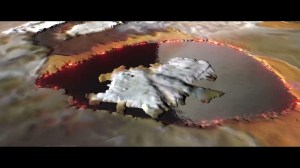
The six-wheeled geologist spotted the twister as part of an atmospheric exploration of Jezero Crater.
The lower portion of a Martian dust devil was captured moving along the western rim of Mars’ Jezero Crater by NASA’s Perseverance rover on Aug. 30, 2023, the 899th Martian day, or sol, of the mission. The video, which was sped up 20 times, is composed of 21 frames taken four seconds apart by one of the rover’s Navcams.
Much weaker and generally smaller than Earth’s tornadoes, dust devils are one of the mechanisms that move and redistribute dust around Mars. Scientists study them to better understand the Martian atmosphere and improve their weather models.
Using data from the imagery, mission scientists determined that this particular dust devil was about 2.5 miles (4 kilometers) away, at a location nicknamed “Thorofare Ridge,” and moving east to west at about 12 mph (19 kph). They calculated its width to be about 200 feet (60 meters). And while only the bottom 387 feet (118 meters) of the swirling vortex are visible in the camera frame, the scientists could also estimate its full height.
“We don’t see the top of the dust devil, but the shadow it throws gives us a good indication of its height,” said Mark Lemmon, a planetary scientist at the Space Science Institute in Boulder, Colorado, and a member of the Perseverance science team. “Most are vertical columns. If this dust devil were configured that way, its shadow would indicate it is about 1.2 miles (2 kilometers) in height.”
Dust devils, which occur on Earth as well, form when rising cells of warm air mix with descending columns of cooler air. The Martian versions can grow to be much larger than those found on Earth. And while they are most prominent during the spring and summer months (Mars’ northern hemisphere, where Perseverance is located, is currently in summer), scientists can’t predict when they’ll appear at a specific location. So Perseverance and its fellow NASA Mars rover Curiosity routinely monitor in all directions for them, taking images in black-and-white to reduce the amount of data sent to Earth.
More About the Mission
A key objective for Perseverance’s mission on Mars is astrobiology, including the search for signs of ancient microbial life. The rover will characterize the planet’s geology and past climate, pave the way for human exploration of the Red Planet, and be the first mission to collect and cache Martian rock and regolith (broken rock and dust).
Subsequent NASA missions, in cooperation with ESA (European Space Agency), would send spacecraft to Mars to collect these sealed samples from the surface and return them to Earth for in-depth analysis.
The Mars 2020 Perseverance mission is part of NASA’s Moon to Mars exploration approach, which includes Artemis missions to the Moon that will help prepare for human exploration of the Red Planet.
JPL, which is managed for NASA by Caltech in Pasadena, California, built and manages operations of the Perseverance rover.
For more about Perseverance:
Media Contacts
DC Agle
Jet Propulsion Laboratory, Pasadena, Calif.
818-393-9011
agle@jpl.nasa.gov
Karen Fox / Alana Johnson
NASA Headquarters, Washington
202-358-0668 / 202-672-4780
alana.r.johnson@nasa.gov / karen.c.fox@nasa.gov
2023-138
































